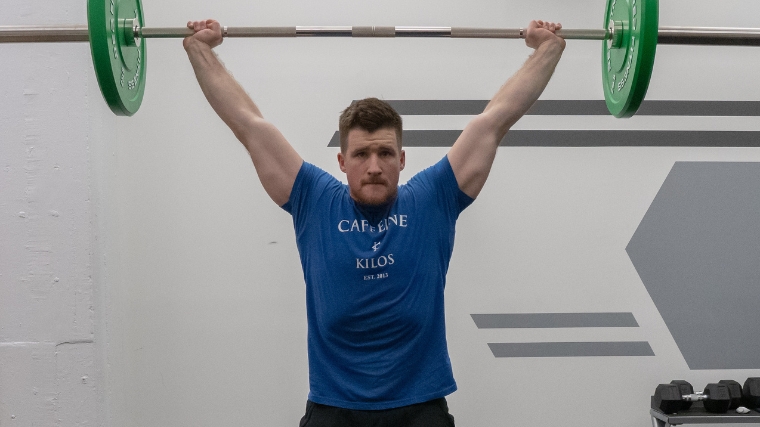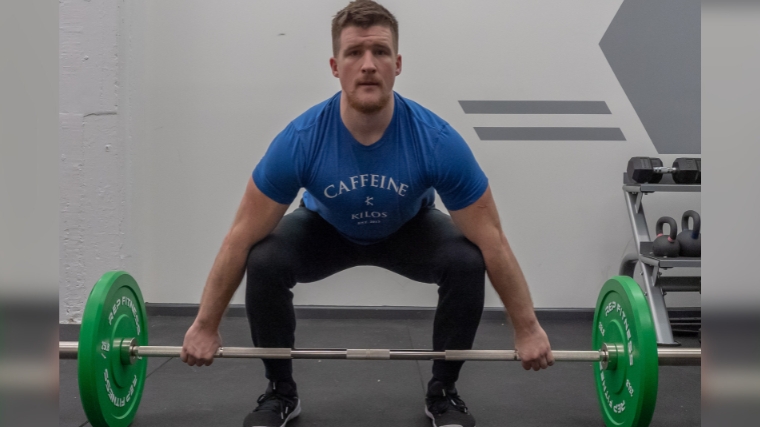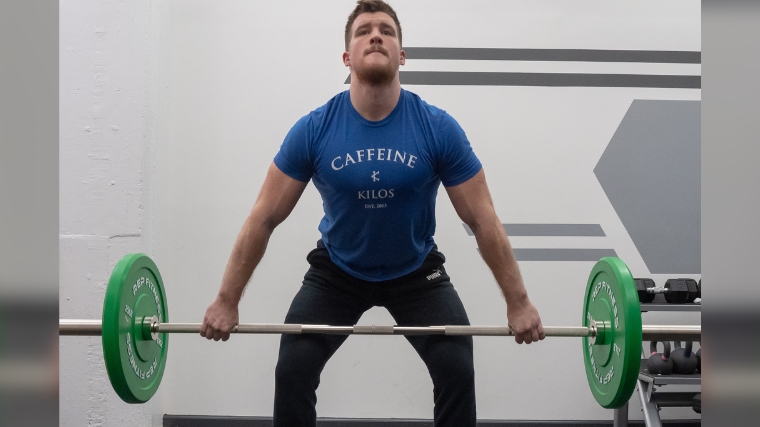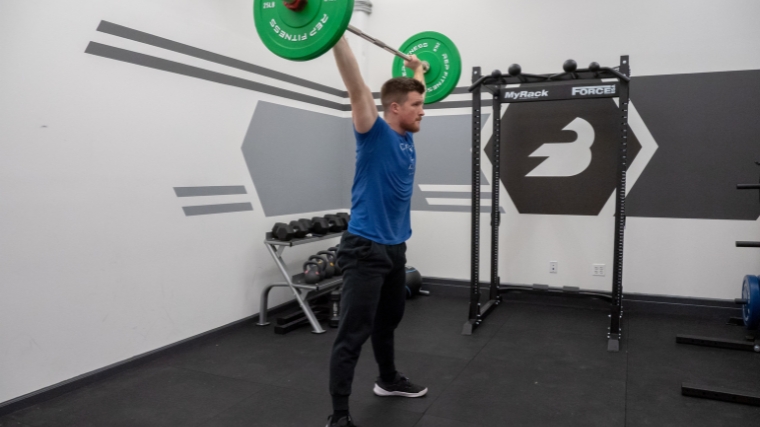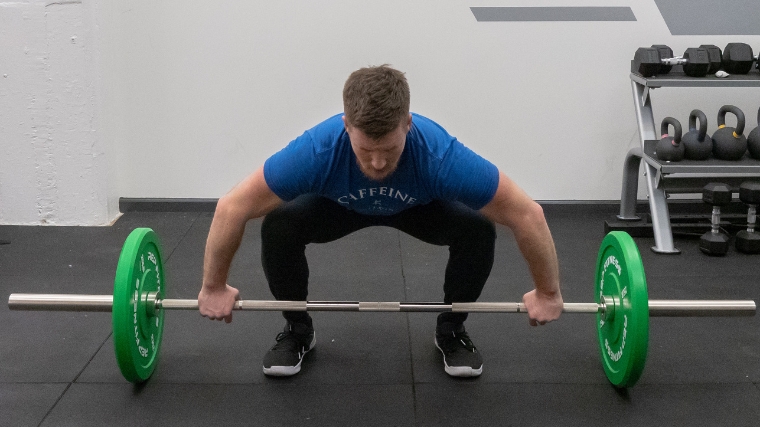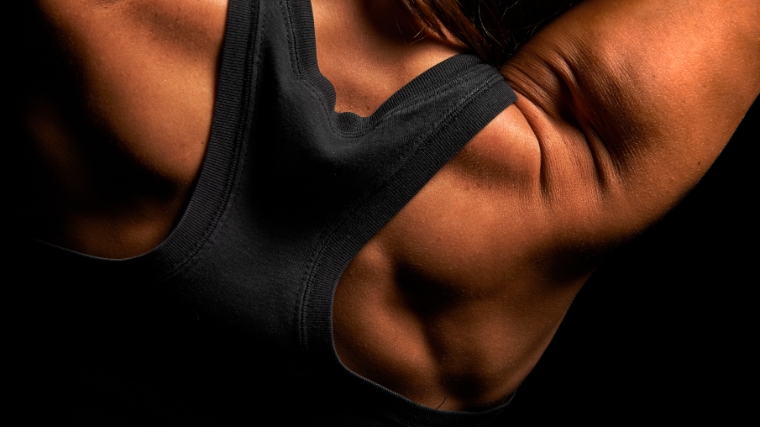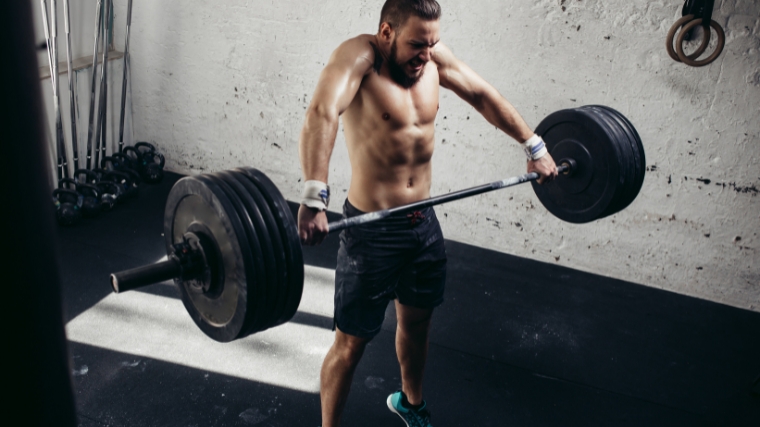How to Do the Muscle Snatch for Better Weightlifting Performance | BarBend (original) (raw)
If you’re on the hunt for a new way to improve your weightlifting game, the muscle snatch is an absolute game-changer. The muscle snatch can help you build explosive leg power, teach you how to be a powerful and aggressive vertical puller, and reinforce solid snatching mechanics to boot.
The tremendous amounts of strength and control that you will earn from the muscle snatch will only boost your confidence and spread across all of your main lifts. You’ll be a better snatcher in, basically, the blink of an eye.
This is your deep-dive on the muscle snatch — and why it’s one of the best weightlifting accessory exercises out there.
- How to Do the Muscle Snatch
- Muscle Snatch Sets and Reps
- Common Muscle Snatch Mistakes
- Muscle Snatch Variations
- Muscle Snatch Alternatives
- Muscles Worked by the Muscle Snatch
- Benefits of the Muscle Snatch
- Who Should Do the Muscle Snatch
- Frequently Asked Questions
You can perform the muscle snatch with a barbell and some bumper plates, or use it as a technique tool. For that, you’d want a wooden dowel or PVC pipe. Here’s a step-by-step guide on how to do a picture-perfect muscle snatch.
Step 1 — Establish Your Setup
Set up in the starting position of your snatch. The bar should be over the middle of your feet, your knees should be slightly in front of the bar, your hips should be slightly higher than your knees, and your shoulders should be atop the bar or slightly in advance of it.
Coach’s Tip: The hook grip is optional for the muscle snatch, though you may want to use it when learning the movement.
Step 2 — Drive With Your Legs
Engage your core and push into the floor with your legs; the first half of the muscle snatch is identical to that of the snatch. The barbell should leave the ground and travel up and slightly back as your knees extend out of the way. Continue to push downward with relaxed arms until the bar approaches mid-thigh.
Coach’s Tip: Keep your arms loose as you push the ground away with your legs. Ensure your chest and hips are rising at the same rate as well.
Step 3 — Aggressive Pull and Turnover
As the barbell approaches your hips, extend your ankles, knees, and hips simultaneously to drive it upward. Do not drop your torso down to catch the bar overhead. Instead, remain in a standing position.
As the bar passes your chest, flip your elbows under it and deliberately press it out overhead. Arrive at a strong, locked-out position without re-bending your legs at any point.
Coach’s Tip: Keep your elbows stacked on top of the barbell as it travels upward for as long as possible and perform the “turnover” at the last moment.
Muscle Snatch Sets and Reps
The muscle snatch is an excellent exercise that can be executed as a primer before your main lifts or as a stand-alone exercise to build strength, explosiveness, and improved body awareness. Here are three of your programming options:
- As a Warm-Up: Perform 2-3 sets of 5-10 reps with an empty barbell; rest 1-2 minutes between sets.
- For Strength: Perform 2-4 sets of 1-5 reps with moderate-heavy weight on the barbell; rest 2-4 minutes between sets.
- For Muscular Endurance: Perform several sets of 10+ reps with a very light weight on the barbell; rest for 1-3 minutes between sets.
Common Muscle Snatch Mistakes
The muscle snatch may seem very simple and easy to do, at least compared to the snatch itself. However, there’s plenty that can go wrong and several things you can easily overlook. Here are a few common mistakes to look out for so you can get the most out of the muscle snatch.
Upper-Body Reliance
Most weightlifters perform the muscle snatch with an unloaded or very lightly loaded barbell. As such, you might be tempted to rip the bar off the ground and use the muscles in your upper body too soon.
No matter what weight you’re working with, treat each repetition as if it were a properly-loaded snatch. Let your lower body do the work before you finish with your arms, and avoid bending your elbows early. Drive with your legs from the start.
Early Elbow Bend
How your arms behave during a muscle snatch will determine the trajectory of where your bar goes. For example, if your arms bend too early, then you might end up changing the direction the bar is traveling. In addition, early arm bend can lead you to failing the lift or even developing a bad habit in your technique, such as kicking the bar out in front of you.
Going Too Heavy
The muscle snatch is a technique tool, not a strength-building exercise. If the weight is too heavy, you won’t be able to hit the beats of a proper pull. Load too heavy and you might lean back too far, bend your arms early, or simply be unable to drive the bar high enough in the first place.
Muscle Snatch Variations
In weightlifting, regularly rotating in some movement variations are essential since you can only do the same exercise so often until it becomes stale and boring. Switching things up is a good way to ensure you’re still having fun while maintaining the spirit of the original exercise.
Single-Arm Kettlebell Muscle Snatch
This excellent muscle snatch variation can be done with a kettlebell and performed with one or both arms. You will still be reaping the core benefits of a muscle snatch. but now with an added twist of additional unilateral training.
Working with kettlebells is a great way to induce a different type of stimulation to the muscles that bear the most load during the muscle snatch. Furthermore, weightlifting is an entirely bilateral sport; you work with both arms at the same time. Accessory exercises are the perfect time to get some unilateral work in there for variety’s sake.
Hang Muscle Snatch
The uniqueness of this exercise is that it completely eliminates the entire first portion of the pull, so you have less to focus on. This should help you generate more momentum and explosiveness through the second pull, to build more powerful hips and a strong overhead position.
The hang muscle snatch is also easier to learn, since there’s a limited range of motion. This movement makes for a great introduction to the snatch as a whole if you’re interested in trying the Olympic lifts.
No-Contact Muscle Snatch
Hip (or thigh) contact is integral for power development in weightlifting. Remove it and you’ll find yourself limited in how much force you can produce. As a training tool, though, no-contact drills can be quite productive.
If you’re prone to slamming your hips into the barbell during snatches and thus looping the bar outward, intentionally performing the muscle snatch without any hip contact can help you feel what a proper vertical bar path should be. The no-contact muscle snatch will also challenge your arms and upper back to a greater degree, since you lose some “kick” by not touching the bar to your hips.
Muscle Snatch Alternatives
While the muscle snatch is one of the easiest and most straightforward accessories in the sport of weightlifting, it’s still no walk in the park. You may not have access to a barbell or the inclination toward the exercise in the first place. In such cases, here are a few alternatives:
Medicine Ball Muscle Snatch
This is a tremendous beginner-friendly option for those wanting to learn the muscle snatch. Most medicine balls are lighter than your average barbell, and because of the shape of the ball, gripping it can feel more natural.
Another benefit of this movement is that holding the ball close to your center of gravity means you won’t have to worry about colliding with your knees or having a loopy bar path.
Sandbag Muscle Snatch
This option is very similar to a medicine ball muscle snatch, but allows you to practice the exercise with a broader arm position to mimic the snatch grip position of a muscle snatch.
Furthermore, sandbags are inherently unstable. They’re hard to work with and are prone to shifting. If you value upper-body joint stability above all, this could be a good option to work into your accessory training.
Hang Dumbbell Muscle Snatch
Most gyms have a wide assortment of dumbbells for you to work with. As such, you can swap the barbell out and go for a double-dumbbell muscle snatch with a weight that exactly matches your strength levels.
Dumbbell overhead work is also quite common in CrossFit workouts. If you want a rock-solid dumbbell snatch, working with dumbbells for your muscle snatches is only logical.
Muscles Worked by the Muscle Snatch
The muscle snatch requires you to be mentally and physically tuned into your body. Put simply, you need good proprioception. The more you can understand what muscles are working, the better you’ll be able to use them to successfully complete a muscle snatch.
Legs
Your legs are the focal point of where you generate power throughout the muscle snatch. The primary muscle groups at play are your quadriceps, glutes, and calves. Your quadriceps will help you push through the floor to extend your legs as you’re raising the bar from the ground. The glutes will also assist you by extending your hips at the top of the pull, and your calves will provide a small amount of vertical force as you rise up onto your toes.
[RELATED: Best Leg Workouts]
Core
Your ability to brace your core throughout the muscle snatch will be the key to whether or not you’ll make a successful lift. The main core muscles at play here will be the transverse abdominis, rectus abdominis, and internal and external obliques.
Your erector spinae — that’s your lower back muscles — are also considered a part of your core. You need a strong isometric contraction throughout your lumbar spine to facilitate the transfer of force from your legs into the barbell.
Upper Back
Your upper back plays a vital role in successfully completing a muscle snatch. The musculature of the upper back that performs the most work is the trapezius, the latissimus dorsi, and the rotator cuff complex.
Credit: SvedOliver / Shutterstock
_[Read More: The Best Shoulder Exercises for Bigger, Stronger Shoulders]
All of these muscles will work isometrically throughout the lift as you transition through the end phase of the second pull as you aggressively pull the bar to elbow height and follow through with the turnover.
Shoulders
The shoulder complex is composed of many muscles including the supraspinatus, infraspinatus, teres minor, subscapularis, deltoids, trapezius, and the serratus anterior. Since the shoulder is a ball and socket joint, this joint has a tremendous amount of range of motion. You will use these muscles in stabilizing the barbell in both phases of the lift and especially during the turnover portion of the muscle snatch.
Benefits of the Muscle Snatch
By now if you’re not convinced that you should be doing the muscle snatch, here are a few additional reasons that should persuade you.
Builds Explosive Power
If you’re having a difficult time being intentional and aggressive with your leg drive, hip extension, or turnover, the muscle snatch is a great resource for you. Since you’re working with such light weight relative to how much you’re able to snatch, you have a great opportunity to reinforce good mechanics and improve your power output.
Teaches You to Keep the Bar Close
A close, tight bar path is crucial for both of the Olympic lifts. The muscle snatch is particularly useful for learning how to “keep the bar close” as you pull. You can’t drop down and catch the barbell in a squat; you have to send it straight upward.
Therefore, any deviation in bar path will dramatically reduce how much you can muscle snatch. You’ll immediately feel the difference between a tight, vertical muscle snatch and one with an errant bar path. The movement is invaluable for providing tactile feedback.
Reinforces Constant Pressure
Plenty of weightlifters make the mistake of taking it easy during light-weighted snatches or cleans, instead of applying constant pressure to the barbell. As a result, they can develop inconsistent technique.
When you perform the muscle snatch, the bar must fly up to arm’s length; if you don’t elevate it high enough, you can’t perform the lift. As such, the muscle snatch is phenomenal for encouraging a full and continuous pull, rather than cutting your power generation short.
Encourages Aggression
Olympic-style lifting requires both precision and aggression. You need to be intelligent about your technique and timing while also being extremely explosive at very specific moments; you can’t have one without the other if you want to excel.
The extreme bar height required during the muscle snatch will drive these points home for you, whether you like it or not. If you don’t step on the gas as the barbell approaches your hip, it will not fly high enough to press it out with your arms.
Who Should Do the Muscle Snatch
You don’t necessarily need to be a weightlifter to install the muscle snatch into your program. That said, it is, above all, an Olympic lifting accessory movement. Here’s why it is so important to weightlifting training and how it applies to athletes off the platform as well.
Weightlifters
The snatch and clean & jerk — weightlifting’s two competitive disciplines — are more than the sum of their parts. That said, each individual part matters, and any good weightlifter should have at least one accessory exercise in their toolbox to address every individual aspect of each lift.
The muscle snatch is an invaluable complement to the snatch because it reinforces all the critical elements of snatching; power development, proper timing, and a vertical bar path. It’s also fairly grab-and-go, meaning you don’t need to go through a robust warm-up or mobilization routine to start muscle snatching.
CrossFit Practitioners
CrossFit programming draws heavily on the sport of weightlifting for many of its various workouts. However, in CrossFit, snatches or cleans are often done with submaximal weights for many repetitions strung together.
Credit: UfaBizPhoto / Shutterstock
[Read More: The Best Upper Body Exercises and Workouts]
The muscle snatch is a great option for drilling your bar path, which should carry over to your metcons or weightlifting-inspired WODs. A tight bar path means less energy wasted, which means you can string multiple reps together in quick succession.
Muscle It Up
Technique, control, and strength all matter in the sport of weightlifting. The snatch and clean & jerk may be lower-body-dominant exercises, but that doesn’t mean your arms and shoulders have nothing to do with your success.
The muscle snatch teaches you how to use your upper body properly. By intentionally lifting “incorrectly” — that is, pulling and pressing on the barbell with your arms to get it over your head — you can trick yourself into doing it right when it matters.
It’s also a huge confidence-builder to have one single movement that reinforces nearly every aspect of sound performance. After all, perfect practice makes perfect on the platform, and the muscle snatch can help get you there.
FAQs
Here are some commonly asked questions about the muscle snatch that may be of use to you.
Why should I do the muscle snatch?
The muscle snatch serves as an accessory exercise in weightlifting, meant to improve your timing, bar path, and upper-body strength during the snatch itself.
How heavy should I go on the muscle snatch?
When it comes to the muscle snatch, lifting heavy isn’t the focus; technique and control are what matter. If the bar is too heavy, you’ll lose out on a lot of valuable tactile feedback that carries over to the snatch itself. Your muscle snatches should be light and snappy.
When should I do the muscle snatch?
Most weightlifters will perform muscle snatches early on in their training sessions as part of their warm-up. Doing so can help you prime your mind to hit all the beats of a good snatch when you start loading up your barbell.
Featured Image: Riley Stefan
